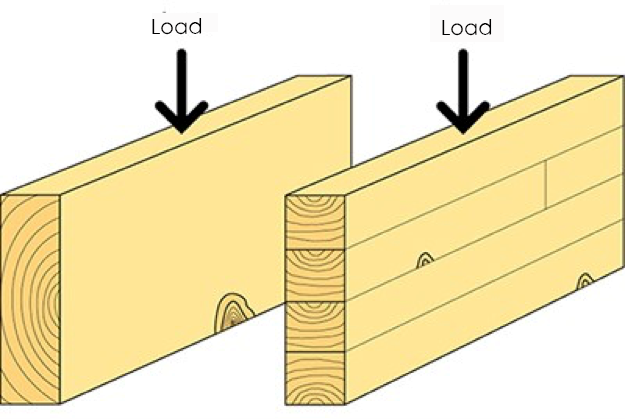Manufacturers & manufacture
Glulam is manufactured industrially under controlled conditions. Very long lengths can be produced with the help of finger-jointing technology. The engineering principle is simple:
wood laminates (beams or planks) are stacked and bonded together to make large structural components. Size and length are limited largely by the transport options.
The glulam industry was instrumental in the creation of an independent control body back in the 1960s. For a few years now, SP Technical Research Institute of Sweden has been the official control and certification body for glulam manufacture in Swede
Glulam is both stronger and stiffer than solid wood of the same dimensions. This is due to what is known as the lamination effect: laminates of various strengths are mixed to produce the glulam. There is only a very small risk of defects in several laminates occurring in the same cross-section. The wood laminates are also strength-graded and the strongest laminates are placed in the outer zones, where the stresses are normally greatest. The strength of an individual plank, on the other hand, is determined by its weakest point – usually at a large knot or similar.
The difference in strength between different planks can be substantial.

The lamination effect for glulam: In glued laminated timber, there is only a very small risk of defects, such as large knots, occurring in the same section. However, a single knot can significantly lower the strength of a solid wooden beam.
Certification and control
Glulam structural components are manufactured industrially under controlled conditions. Very long lengths can be produced with the help of finger-jointing technology. The engineering principle is simple – lengths of wood laminates are stacked and bonded together to form large structural components. The size of the glulam products is limited firstly by the transport options and secondly by the manufacturer’s premises and equipment.
Sweden has four long-established manufacturers of glulam. Every country has one or more accredited certification bodies that are responsible for certifying, checking and testing glulam products. Good experiences of glulam are prompting a steady increase in its use across Sweden.
CE marking
CE is a product label within the EU. A product that is CE marked can be sold within the EEA without any further documentation. If a product carries the CE mark, it shows that the manufacturer has complied with the basic requirements set out in the relevant EU Directives. CE marking relies on the existence of a harmonised standard. Only glulam that meets the harmonised standard for glulam can carry the CE mark.

The CE mark is used in many different product areas.
Glulam manufactured in Sweden complies with the harmonised standard SS-EN 14080. To show that the glulam products meet the requirements contained in SS-EN 14080, they must be CE marked and have a performance declaration. The standard sets out the documents required for verification.
CE image
Beams, irrespective of the laminate count, are produced in Sweden in strength classes GL30c or GL30h, while split timber beams are manufactured in class GL28cs. The letter c stands for combined and h for homogeneous. The letter s stands for split.
Production control
Glulam manufacture demands considerable precision not least in milling the finger joints, preparation and application of the glue, compression force and compression time. Ongoing checks are made to ensure that the glulam products maintain a constantly even and high quality. These checks involve sample blocks regularly being taken for testing of their strength and durability.
The accredited certification body monitors the self-assessments and visits the glulam manufacturers for unannounced inspections. The glulam manufacturers are subject to constant monitoring by the accredited certification body.




